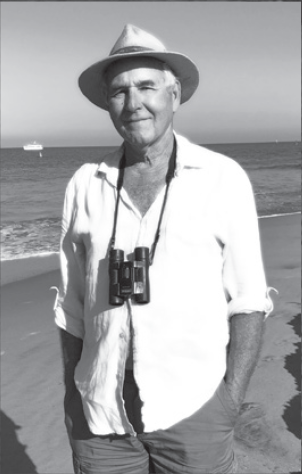Editor’s Note: We just received word that Timothy Bottoms is making an appearance for a book talk and signing at Chaucer’s on Wednesday, April 19 at 6 p.m.
New Book ‘The Pier’ Takes Place on Santa Barbara’s Stearns Wharf
From Stern to Stearns with Timothy Bottoms

Well-known as an actor in a family of actors, Timothy Bottoms (The Last Picture Show, The Paper Chase) has recently turned his creative talents to the page. He is the eldest of the Bottoms brothers (Joseph, Sam, and Ben) who all grew up in Santa Barbara as the sons of Betty and James “Bud” Bottoms, the sculptor who created the iconic Dolphin Family Fountain at the entrance to Stearns Wharf. Timothy’s new book The Pier, a coming-of-age story loosely based on his childhood memories, is set in that very place.
Here, Bottoms discusses his new novel with Independent writer David Starkey.
The Pier covers an extraordinarily eventful day in the life of an 8-year-old boy who is going fishing alone on Stearns Wharf, in 1959, for the very first time. To what extent does this mirror your own experience, and how much is drawn from your imagination? And is that distinction even important to you as a writer? Bottoms: Stearns Wharf was always a favorite place for me and my family. To me, the pier is an old friend that endured time and outlived many of my family and friends. The wharf was old when I met her and through time has constantly changed but still stands. A place to dream. A place to witness fishing and all the sea life from the surface. Looking down the pilings at all the life supported there is amazing. Many of my fishing memories take me there. Remembering friends old and young, fish caught and lost, buildings, hoists, and boats. The loading and unloading of fish and fishermen gave me the foundation for this story. Freeing my imagination was so much fun because I could take the reality I remembered and create a story. Some of it happened, and some of the people were combinations of several people. As a writer, I need to write about what I know and have experienced; add my imagination, and I have a story to tell.
Fishing — including what happens before and after the actual endeavor itself — clearly carries a lot of symbolic weight in the book. What do you feel children, and adults, can learn from “the art of fishing”? Patience is very important. Sharing your knowledge of the sport. Having the right gear and knowing how to use it depending on the fish you want to catch. Kindness to strangers is a theme that I learned from my mother, father, and mentors. Giving, too. Be it tackle, spare change, or a gift has always brought a smile and felt good in my heart. Being given a gift — a fish, in this story — is such a relief when one needs it. What a meal.

Some people might think of fishing as a solitary sport, but the fishermen in The Pier are so interconnected. In the 1950s, my father and his friends created the Santa Barbara Sportsman’s Association, a group of veterans. Big fish, abalone, lobsters, wild pork and venison, ducks, quail, and dove were always on the table. Times were tough, and the ocean, local ranches, and forests provided; one just had to go out and get it. Being a fisherman carries some responsibility as well, so if a fish is too small for a meal, return it to the sea.
Did your long, distinguished career as an actor provide you with any insights about how to tell a story? Telling stories is in my DNA. As a child, I earned the name “Tall-Tale Timmy.” Acting was a perfect fit. Instead of going to college to further my education, I ran away and joined the circus called Hollywood. Auditions with a couple of pages of dialogue and taking direction were always a fun challenge. Booking a part in a film, having the table read, rehearsals for the camera, then shooting the scene ignited the passion to write. Meeting directors who also wrote the scripts was exciting and something I wanted to pursue. The Pier was written as a screenplay, then changed into a short story. So I suppose my career in theater, television, and film helped immensely in my journey as a storyteller.
The events in this story, semi-autobiographical as they seem to be, took place a long time ago. Why does now feel like the right time to bring out The Pier? Our world is changing, and fish as well as many other species of critters are disappearing. Before the blowout at the oil platform in 1969 covered our beaches with goo, life under the surface of the ocean off Santa Barbara was a vibrant color-filled world, with so much life. A wonderland under the sea. Dale Howell made me a full wetsuit when I was 8. I got to go, with my dad, out on the Marie to dive off the back side of Santa Cruz Island. This experience, witnessed through my faceplate from the surface, exposed me to a fantastic world under the sea, giving me memories to write about. Bringing back those memories of the late 1950s and sharing them with the world and particularly my hometown, might, with the help from the elders, inspire the next generation’s imagination of what they can do to help clean up and create safe, protected nurseries for all the amazing life under the surface. And maybe, just maybe, bring that pristine past back from extinction.




You must be logged in to post a comment.